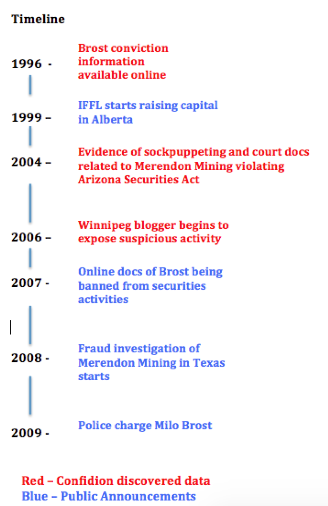The ever increasing availability of “online data” provides investors, big and small, with a tremendous new opportunity to enhance their due diligence capabilities. To demonstrate some of this potential, Confidion undertook an analysis of indicators of questionable activities discovered through citizen comments in social media channels and “open gov” databases around three investment fraud cases that played out in Alberta’s courts in 2012. Our objective was to see if there were warning signs before the criminal and regulatory investigations became public.
In one example we studied, criminal charges were laid against Gary Sorenson, of Merendon Mining, and Milowe Brost of the Calgary-based Institute for Financial Learning (IFFL) in 2009. The pair was accused of defrauding around 3,000 people in Canada, the USA and overseas out of anywhere from $100 million to $300 million between 1999 and 2008. Sorenson, Brost and Dennis Morice of Arbour Energy were also fined by the Alberta Securities Commision for what was one of Canada’s biggest frauds. Our research suggests that publicly available Internet sources (including social media) provided early indicators of suspicious activity in the investment scheme, long before criminal charges were made public. The evidence of suspicious activity found online, (depicted in the timeline graphic below), might have provided advance warning to investors before they were victimized. This and other studies we have conducted suggest open sources/“online data” research can enhance investor due diligence.
This case illustrates the kind of public information available online that could have served as warning signs to investors and portfolio managers. The information was publicly available for discovery in publicly accessible social media channels long before the criminal investigation became public knowledge. If Confidion’s research methods, (a Google search alone would not be sufficient to uncover warning signs in most cases) had been employed in a timely fashion, investors, investment agents, regulatory authorities, oversight bodies and law enforcement could have been “forewarned and forearmed” of suspicious activity:
- Prompting tougher questions from investors, that might have helped them avoid the deal entirely;
- Raising warning signs after investments were made that steps had to be taken quickly to prevent the loss of all or some of their investments;
- Extending regulators’ reach into cyberspace for information to deepen due diligence research; and,
- Enabling investigators’ to conduct more efficient and comprehensive investigations across borders and time.
In Summary
This is one of three cases we have documented where warning signs were present in open Internet sources. Securities watchdogs, commercial crime investigators, financial firms, even individual investors, have a new resource available to them through public data online; this includes social media, news media and databases of far-off jurisdictions. An advantage of social media today is that people are speaking their minds and sometimes revealing golden bits of information that (when their significance is understood) can lead to critical insights that can save investors and governments millions and reduce instances of fraud.
Please contact us if you would like to learn more about the information represented in the timeline or the other cases we have examined.
Report Author:
Andrea Colson (andrea@confidion.com)
Report Researchers:
Andrea Colson
Kris Pillay
Principal:
Mike MacKinnon (mike@confidion.com)
Head of Investigation Practice:
David Beer (dave@confidion.com)
